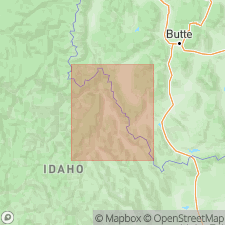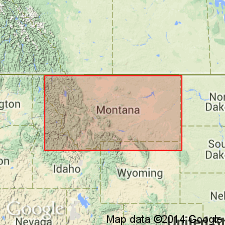
- Usage in publication:
-
- Anaconda Conglomerate*
- Modifications:
-
- Original reference
- Dominant lithology:
-
- Conglomerate
- Breccia
- AAPG geologic province:
-
- Montana folded belt
Summary:
Anaconda Conglomerate. Coarse sedimentary breccia to poorly sorted boulder-to-pebble, well-rounded conglomerate interlayered with lenses of sandstone and siltstone. Maximum thickness 650 feet; thickness at type locality about 390 feet. Unconformably overlies Mesoproterozoic, Paleozoic, and Mesozoic sedimentary rocks. Underlies upper Eocene and Oligocene Renova Formation of Bozeman Group. Interlayered with lower Eocene Lowland Creek Volcanics. Interpreted as a syntectonic sedimentary rock unit related to the formation of the Anaconda metamorphic core complex (O'Neill and others, 2004, Canadian Jour. Earth Sci., v. 41, p. 63-72). Occurs in areas within or directly adjacent to the upper detached plate of the Anaconda metamorphic core complex. Age is considered early Eocene, based on stratigraphic relations.
Type locality: patchy exposures extending from townsite of Anaconda westward to townsite of West Valley, [in T. 4 and 5 N., R. 11 W.], Anaconda North and West Valley 7.5-min quadrangles, Deer Lodge Co., southwestern MT. Named from townsite of Anaconda, Anaconda North 7.5-min quadrangle, Deer Lodge Co., southwestern MT.
Source: Publication.

- Usage in publication:
-
- Anaconda Formation*
- Modifications:
-
- Overview
- Dominant lithology:
-
- Breccia
- Conglomerate
- Sandstone
- Siltstone
- AAPG geologic province:
-
- Montana folded belt
Summary:
Pg. 11, corr. chart. Anaconda Formation. Light-gray, reddish tan, or brownish red, coarse breccia that laterally grades to conglomerate, sandstone, and siltstone. Thickness as much as much as 200 m (656 feet). Locally intertongues with Lowland Creek Volcanics. Derived from overlying unmetamorphosed plate of metamorphic core complex. Age is early Eocene (Bridgerian NALMA).
Not separately mapped. Included with middle Tertiary sediment or sedimenary rocks [undifferentiated].
Source: Publication.
For more information, please contact Nancy Stamm, Geologic Names Committee Secretary.
Asterisk (*) indicates published by U.S. Geological Survey authors.
"No current usage" (†) implies that a name has been abandoned or has fallen into disuse. Former usage and, if known, replacement name given in parentheses ( ).
Slash (/) indicates name conflicts with nomenclatural guidelines (CSN, 1933; ACSN, 1961, 1970; NACSN, 1983, 2005, 2021). May be explained within brackets ([ ]).

